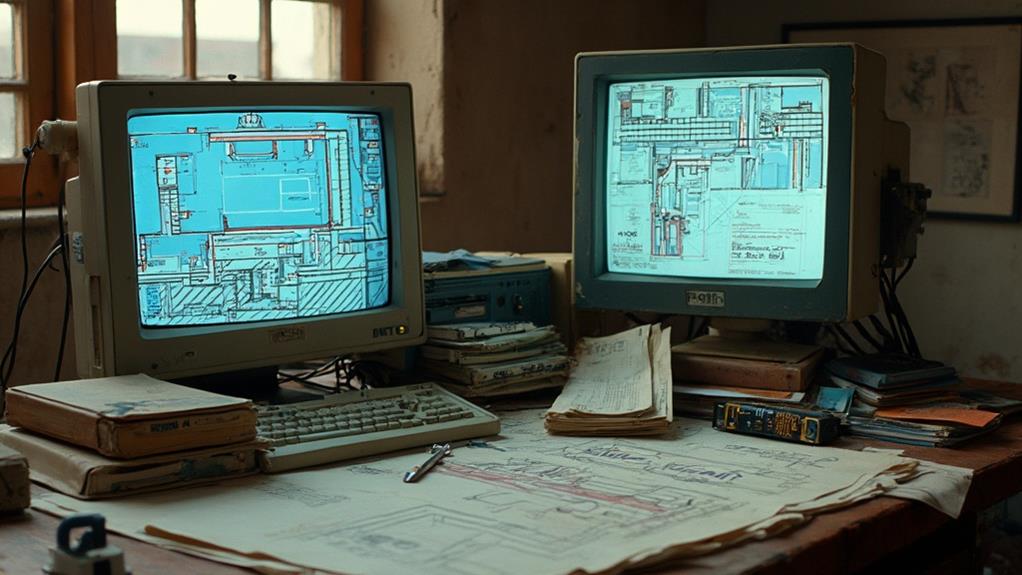Retaining wall engineering software has undergone a remarkable evolution, shifting from rudimentary computational tools to cutting-edge platforms incorporating finite element analysis and intuitive interfaces. Initially designed to facilitate the complex static calculations necessary for preventing erosion, early iterations focused on basic functions like stability analyses and wall sizing. Technological advancements have since revolutionized the field with sophisticated algorithms and user-friendly designs, enabling expansive simulations of soil interactions and load-bearing capacities. These developments have markedly improved design accuracy and efficiency, fostering a cooperative environment among engineers. Exploring its history underscores the pivotal role technology plays in modern structural engineering.
Table of Contents
ToggleWalls Contractor Highlights
- Early software simplified complex calculations, revolutionizing structural analysis and design for retaining wall engineering.
- Advancements in computational technology introduced finite element analysis, enhancing simulation of stress and structural responses.
- Modern tools enable precision, cost-efficiency, and collaborative project management in retaining wall engineering.
- User-friendly interfaces reduce learning curves and foster collaboration, improving accuracy and proficiency in design.
- Initial software was limited by computational power, design capabilities, and unintuitive interfaces.
Origin of Retaining Wall Software

The origin of retaining wall software can be traced to the nascent stages of civil engineering computational tools, where early software development focused on simplifying complex static calculations for engineers. These tools were essential in designing structures to prevent erosion and create usable spaces on properties.
As key technological advancements emerged, these tools evolved from basic computational models to sophisticated systems, integrating finite element analysis and user-friendly interfaces. This progression paved the way for the emergence of modern tools that seamlessly incorporate geotechnical considerations and structural dynamics, fundamentally transforming the practices of retaining wall design and analysis.
Early Software Development
In the nascent stages of retaining wall engineering, software development emerged as a transformative tool that revolutionized the way engineers approached structural analysis and design. As computing technology began to infiltrate traditional engineering practices, early software for retaining wall design tackled complexities previously constrained by manual calculations. Engineers could now simulate multiple scenarios, allowing them to assess load-bearing capacities and soil interaction with unprecedented accuracy.
Prior to this era, design processes relied heavily on empirical methods and hand-drawn calculations fraught with potential human error. The advent of software provided a platform to digitally process vast amounts of data, enhancing precision and consistency.
This period marked a significant shift in engineering, as algorithms were crafted to model soil mechanics, stability conditions, and geotechnical parameters.
These pioneering systems laid the groundwork for a community of engineers who sought not only analytical rigor but also a shared digital language. They engaged in a collaborative pursuit of excellence, creating software that democratized knowledge and facilitated a collective understanding of best practices. This newfound ability to share insights and methodologies strengthened the bond within the engineering community, fostering a culture of innovation and mutual advancement.
Key Technological Advancements
Advancements in computational technology heralded a new era in the development of retaining wall engineering software, introducing sophisticated algorithms that elevated analysis precision. These technological improvements allowed for the shift from rudimentary calculations to comprehensive simulations that emulate real-world conditions with remarkable accuracy. Harnessing the capabilities of high-speed processors and expanded memory capacities, engineers could now perform intricate analyses and design optimizations in a fraction of the previous time required.
The integration of finite element analysis (FEA) revolutionized the field by allowing engineers to simulate stress distributions, soil interactions, and structural responses more effectively. This analytical prowess greatly enhanced the reliability of retaining wall designs, reducing safety concerns and material costs. By employing these advanced models, engineers were empowered to assess potential failure modes and develop more sustainable design strategies.
Moreover, the advent of user-friendly graphical interfaces enabled professionals across experience levels to engage with complex data intuitively. This democratization of technology fostered a collaborative environment that spurred innovation in retaining wall engineering. Additionally, access to an ever-expanding database of geological and structural parameters enriched the decision-making process, embracing a community where knowledge sharing became integral. These technological strides ultimately set the stage for evermore advanced tools and methodologies.
Emergence of Modern Tools
A significant transformation occurred in the field of retaining wall engineering when modern software tools emerged, marking the origin of retaining wall software. This shift from manual calculations and traditional drafting methods revolutionized the industry, ushering in an era where precision and efficiency became paramount. Engineers were now equipped with the capability to model complex interactions between soil and wall structures, ultimately enhancing the design's reliability and safety through advanced computational techniques.
The advent of these tools was driven by a necessity to streamline processes that were once labor-intensive, offering newfound accuracy and speed. As the demands of civil engineering projects increased, so did the complexity of requirements, necessitating tools that could handle dynamic variables and scenarios with ease. Retaining wall software answered this call by integrating geotechnical data and structural analysis models, offering comprehensive solutions tailored to the specific needs of each project.
Moreover, this software fostered a collaborative environment among engineers, designers, and stakeholders. By facilitating communication and allowing real-time updates, teams could guarantee that all aspects of the design process were meticulously considered and optimized. This collective approach not only heightened the quality of engineering outcomes but also instilled a sense of shared purpose and achievement within the community.
Benefits

The utilization of retaining wall engineering software offers significant benefits, including improved design accuracy and enhanced time efficiency, which ultimately contribute to more cost-effective project solutions. By integrating advanced computational tools, the software facilitates precise calculations and modeling, minimizing potential errors and optimizing material use.
This technology is particularly valuable when designing limestone wall installations, ensuring both structural integrity and aesthetic appeal. The software's capabilities extend to various types of retaining walls, including those used in shoreline restoration projects. Additionally, its user-friendly interface empowers engineers with accessible technology, streamlining workflow and fostering seamless project management from inception to completion.
Improved Design Accuracy
Incorporating cutting-edge retaining wall engineering software offers engineers a remarkable enhancement in design accuracy, an essential benefit in structural projects. This advanced technology seamlessly incorporates complex algorithms that allow for precise calculations of loads, pressures, and material strengths, ensuring that each element conforms to stringent engineering standards.
By simulating real-world conditions, engineers can predict how a retaining wall will perform across various scenarios, from static loads to dynamic environmental influences, consequently minimizing risks related to structural failure.
Furthermore, the integration of these sophisticated software tools facilitates detailed analyses during the planning phase, allowing for a meticulous examination of soil-structure interactions and potential stress points. This heightened accuracy is instrumental in preventing costly design errors that can lead to project delays or post-construction modifications. Such precision fosters confidence among project teams, assuring stakeholders of the reliability and durability of their engineered solutions.
Moreover, real-time data processing capabilities enhance collaboration among multidisciplinary teams, streamlining communication and decision-making processes. This collaborative atmosphere strengthens the unity within engineering groups, providing a shared platform for achieving common objectives. Ultimately, the improved design accuracy offered by retaining wall engineering software not only elevates project outcomes but also reinforces the professional integrity of the engineering community.
Enhanced Time Efficiency
Beyond enhancing design accuracy, retaining wall engineering software drastically boosts time efficiency in project execution. Through the automation of complex calculations and the integration of dynamic modeling capabilities, this software significantly reduces the time traditionally required for design development. Engineers, who are constantly pursuing to meet tight deadlines, find themselves with more time to explore into other critical aspects of their projects, ensuring thorough evaluations and optimal outcomes.
The software's ability to quickly simulate various design scenarios and instantly incorporate modifications allows for a fluid and responsive design process. This real-time adaptability empowers a collaborative work environment where team members feel connected and involved, fostering a sense of belonging and collective purpose. By streamlining processes that were once cumbersome and time-consuming, engineers can more adeptly manage vast amounts of data, ensuring that resources are allocated efficiently and effectively.
Moreover, the enhancement in project timelines fosters a positive relationship with clients, as quicker response times lead to higher satisfaction levels. This inclusive approach to time efficiency not only amplifies productivity but also cultivates a harmonious ecosystem where innovation advances and communities thrive in unison.
Cost-Effective Solutions
Implementing retaining wall engineering software often leads to substantial cost savings for engineering firms. By optimizing design processes and providing accurate analysis, this software minimizes material wastage and reduces overhead costs associated with manual calculations and reworks.
The precision offered by such platforms allows engineering teams to strategically minimize excess raw material expenditures while ensuring structural integrity, thereby aligning fiscal responsibility with safety and regulatory compliance. Additionally, the automation of complex calculations and simulations drastically decreases the labor hours required, effectively reducing the overall project time and labor expenses.
Embracing technology in retaining wall engineering fosters a community of forward-thinking professionals empowered by innovative solutions, consequently enabling greater collaboration and shared learning opportunities. The rapid exchange of ideas and knowledge through digital networks supported by this software enhances the collective expertise of the field, allowing firms to stay competitive in a constantly evolving industry landscape.
Furthermore, the reduction in errors due to software accuracy contributes to a more predictable budgeting process, allowing firms to allocate resources effectively and maintain financial stability. This effective resource management and alignment of engineering goals with cost-efficiency are key facilitators of long-term sustainability and success for engineering firms.
User-Friendly Interface
The shift towards technology not only optimizes costs but also elevates the user experience through retaining wall engineering software, particularly with a user-friendly interface. In this increasingly digital age, professionals in the field of civil engineering endeavor to feel part of a community that shares common goals and understanding.
A user-friendly interface forms the cornercornerstone of this shared experience, simplifying complex engineering tasks while encouraging collaboration and efficiency. By enabling seamless navigation and intuitive use, these interfaces substantially reduce the learning curve associated with mastering engineering software tools, making them accessible to a broader demographic of professionals.
Moreover, user-friendly interfaces foster an environment where accuracy and proficiency thrive. They allow engineers to focus on strategic decision-making rather than becoming entangled in the intricacies of software operation. When tools are easy to use, project teams are more effectively integrated, promoting a sense of belonging among professionals working together on intricate retaining wall projects.
Remarkably, this aspect of software design contributes to enhanced data accuracy and streamlined workflows. In uniting technical rigor with accessibility, the user-friendly interface not only elevates productivity but also creates and nurtures a collaborative engineering community, aligned in pursuit of excellence.
Early Software Limitations Explored

In the early stages of retaining wall engineering software development, engineers faced notable limitations that affected various dimensions of their work. The computational power of the software was greatly restricted, which hampered its ability to handle complex calculations efficiently, while the basic design capabilities offered were only sufficient for rudimentary projects, often falling short in addressing detailed engineering requirements. Additionally, the user interfaces of these early systems presented numerous challenges, lacking the intuitive design needed to facilitate seamless navigation, as summarized in the table below:
| Limitation | Impact | Area Affected |
|---|---|---|
| Computational Power | Restrictive for complex tasks | Efficiency and Speed |
| Design Capabilities | Limited to basic designs | Project Complexity |
| User Interface | Unintuitive navigation | Usability and Accessibility |
This constrained environment necessitated manual intervention and expertise beyond the software's capabilities to guarantee successful outcomes.
Limited Computational Power
How did early engineering software grapple with the constraints of limited computational power? In the nascent stages of engineering software development, computational power was a scarce resource. These early systems operated under stringent limitations, where efficient use of available resources was paramount.
Retaining wall engineering software, designed to aid engineers in structural calculations and designs, confronted these hurdles by relying on streamlined algorithms and simplified models. The focus was on delivering essential functions without overburdening the computational capacity, mandating strategic prioritization of core aspects of wall stability analysis.
Programmers of that era ingeniously crafted solutions to maximize the output from minimal hardware capabilities. They implemented iterative methods and linear approximations, which, while lacking the precision of today's tools, provided invaluable assistance to engineers seeking to understand complex soil-structure interactions. This required a harmonious blend of software sophistication and hardware frugality.
Consequently, it was through the collaboration of computer scientists and civil engineers that these pioneering programs were able to evolve and demonstrate impressive versatility within their limited boundaries. Through meticulous coding practices and an understanding of the bare essentials of design physics, they forged pathways to progress that would underpin future advancements in engineering software.
Basic Design Capabilities
Early engineering software for retaining wall design offered basic design capabilities, primarily influenced by the period's technological constraints. During this nascent stage, software served as a pioneering tool for engineers aiming to overcome the imprecisions of manual calculations.
These programs focused on essential functions such as stability analyses and initial sizing of wall elements, anchoring their processes in fundamental engineering principles. While rudimentary by today's standards, these applications laid the groundwork for more sophisticated technologies by addressing the immediate need for efficiency in calculating earth pressures, surcharge loads, and factor of safety assessments.
Essentially, these early solutions provided users with the means to analyze predefined wall types and limited configurations, harnessing available computational power. However, inherent limitations existed, such as simplified assumptions regarding material properties and soil-structure interactions.
Despite these constraints, engineers experienced a cohesive sense of progression and innovation as they adapted to and embraced the capabilities at their disposal, uniting professionals in a collective journey towards advancing design methodologies. In addition, the straightforward interfaces reduced the learning curve for practitioners, fostering a sense of inclusion and shared purpose within the engineering community, consequently encouraging a gradual yet significant transformation of the way retaining walls were conceptualized and designed.
User Interface Challenges
The journey into early retaining wall engineering software reveals a backdrop of user interface challenges that shaped the user experience. Initially, these programs were designed with a focus on fundamental computation rather than usability. Engineers found themselves traversing unnecessarily complex and unintuitive interfaces, which hampered productivity and increased the potential for error. Such software was markedly different from today's slick, user-centered designs that prioritize efficiency and accessibility.
These early challenges in software design primarily stemmed from:
- Limited Graphic Capabilities: The user interfaces lacked visual appeal and clarity, often relying solely on text-based commands.
- Intricate Navigation: The software required users to memorize elaborate sequences of commands, leading to steep learning curves.
- Sparse Documentation: Missing or inadequate guidance materials meant users often had to rely on intuition or seek peer assistance.
These obstacles often left engineers feeling isolated, as the tools available did not facilitate an intuitive connection between the user and the software. Consequently, the need to feel part of a supportive community of practice became pivotal. Over time, this sense of belonging would be fostered by forums and support networks that allowed users to share insights and collaborate, paving the way for future advancements in retaining wall engineering software.
Walls Contractor FAQ
How Do Modern Retaining Wall Software Programs Ensure Data Accuracy?
Modern retaining wall software guarantees data accuracy through advanced algorithms, integration with geotechnical databases, and precise modeling tools. These programs foster reliability and confidence in users' designs, creating a sense of community and shared purpose among engineering professionals.
What Are the Common Programming Languages Used in Retaining Wall Software?
Modern retaining wall software chiefly utilizes programming languages such as Python, C++, and Java due to their robust computational capabilities. These languages foster high-quality, reliable engineering solutions, reinforcing our commitment to creating a cohesive professional network within the industry.
How Has Cloud Computing Impacted the Development of Retaining Wall Software?
Cloud computing has tremendously advanced the development of retaining wall software by enabling seamless collaboration, enhancing data accessibility, and improving computational efficiency, fostering a sense of community among engineers who can now share resources and insights globally.
Are There Open-Source Alternatives to Proprietary Retaining Wall Software?
Several open-source alternatives exist, such as GeoTechTools and WALL123D, offering engineers a sense of community and collaboration. These platforms provide an inclusive space for innovation and shared knowledge, fostering advancements in retaining wall design without proprietary constraints.
How Do Engineers Choose Between Different Retaining Wall Software Programs?
Engineers select retaining wall software based on criteria including functionality, user support, cost, interface ease, and compatibility with existing systems. Peer reviews and industry standards also influence decisions, ensuring alignment with both technical needs and community acceptance.







